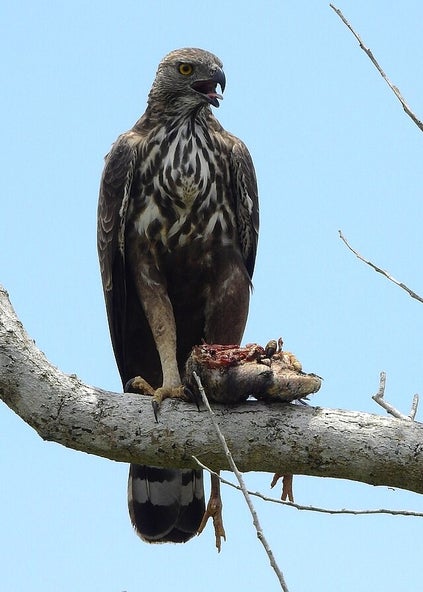Predation

Changeable Hawk Eagle,
Nisaetus cirratus
Raptors are a major force in creating and maintaining the structure of the avian community by keeping numbers of some birds down and sometimes the overexploitation of a resource. Hawks and owls either eat small birds or cause them to forage less frequently for fear of being eaten, reducing both inter-and intraspecific competition among those birds.
Wytham Woods at Oxford University, a 937 acre (375 hectare) of mixed deciduous forest, has been a venue of considerable bird research for many years. The Blue and Great Tit populations have been studied there since 1947 and virtually every individual bird of these two species has been banded. Approximately 1000 nest boxes have been provided for the birds, so there are good data on all aspects of their lives, including predation pressure. Sparrowhawks take 20-25 percent of the tit population each year, but the tits’ breeding population remains steady. The decrease in their numbers simply makes room for immigrant tits, mostly young birds looking for a place to nest.
Predation may affect a bird community directly by reducing prey number or indirectly by causing the birds to change their behavior. One study in Finland measured the distances of songbird nests from a nesting European Kestrel; as expected, there were fewer nests of songbirds near the kestrel nest than there were farther away. Kestrels prefer open habitats and studies of prey birds in simple ecosystems like farmlands indicate that prey species tend to space themselves a good distance from the predator’s nest; this predator-avoidance effect can extend to a distance of half a mile or more (about a kilometer). The farther away the potential prey species is, the more likely they will see the approach of a predator and have the opportunity to escape. A similar study on a forest-dwelling raptor, the European Sparrowhawk, showed a minimal effect on the nesting distance of nearby songbirds because in this study there were more locations (bushes, shrubs, trees) to build nests in and more places to conceal themselves nearb
Some researchers argue that the non-lethal effects of predation (not being eaten) are at least as strong if not stronger than the lethal (being eaten) effects. Birds change their behavior to avoid predation and may spend less time foraging, which might be critical to survival, especially in the winter, or feed their young less in the breeding season, resulting in lower nesting success. The threat of predation may even keep birds from defending their territory sufficiently or from attracting a mate.
Birds don’t just casually sit around and wait to get picked off or cower in the presence of a predator. There are numerous anti-predator mechanisms that prey birds employ to survive – escaping, hiding, possessing cryptic coloration, and feeding in flocks as more eyes mean a better warning system. They have also evolved specific behaviors like the broken wing act of the Killdeer. The broken wing act is a distraction display to lure potential predators away from the nest. The bird fakes an injury to its wing by flopping and dragging it along the ground, with the predator following. At a safe distance from the nest the wing miraculously heals and the bird flies off. This strategy is only effective for terrestrial predators, not aerial ones, however. Other birds employ this ruse as well such as the Mourning Dove and various Lapwings. (I used to think that the name “lapwing” derived as a result of this behavior but it actually refers to the erratic flapping flight of the birds.)
Sunbitterns (below) of South and Central America inhabit open edges of rivers in tropical forests and are susceptible to predation by raptors. They are not fast fliers and prefer to walk unless crossing a river. When threatened, they spread their wings and tilt them vertically, and raise their tail to fill the space between. The wings, with their rufous, gold, and black patterns, resemble a pair of menacing eyes of a large animal. Males, females, and young birds all show this pattern, with no intermediate plumages, indicating that the display is a defensive mechanism and not one of courtship.

Sunbittern, Eurypyga helias